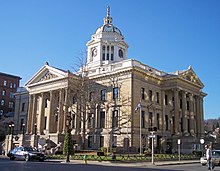Marion County, West Virginia
| Marion County, West Virginia | ||
|---|---|---|

Marion County Courthouse in Fairmont
|
||
|
||
 Location in the U.S. state of West Virginia |
||
 West Virginia's location in the U.S. |
||
| Founded | January 14, 1842 | |
| Named for | Francis Marion | |
| Seat | Fairmont | |
| Largest city | Fairmont | |
| Area | ||
| • Total | 312 sq mi (808 km2) | |
| • Land | 309 sq mi (800 km2) | |
| • Water | 2.8 sq mi (7 km2), 0.9% | |
| Population (est.) | ||
| • (2015) | 56,925 | |
| • Density | 184/sq mi (71/km²) | |
| Congressional district | 1st | |
| Time zone | Eastern: UTC-5/-4 | |
| Website | www |
|
Marion County is a county in the U.S. state of West Virginia. As of the 2010 census, the population was 56,418. Its county seat is Fairmont. The county was named in honor of General Francis Marion (ca. 1732–1795), known to history as "The Swamp Fox".
Marion County comprises the Fairmont, WV Micropolitan Statistical Area, which is also part of the Morgantown-Fairmont, WV Combined Statistical Area.
Although the Adena and successor Hopewell cultures had flourished in this area at one time, the region which includes the land now known as Marion County was sparsely occupied by Native Americans, if at all, in the late 18th century; like much of the Ohio Valley, it had been depopulated by the Iroquois during the later Beaver Wars (1670–1700). Only a few abortive attempts to start European settlements upon the Monongahela River or its branches (such as that which gave its name to Dunkard Creek) are known prior to the French and Indian War, and it was not until the year 1772 that any permanent settlements were made in this region.
Marion County proper was created by an act of the Virginia Assembly on January 14, 1842, from parts of Monongalia and Harrison Counties, and was named after General Francis Marion, of American Revolutionary War fame, known to history as "The Swamp Fox".
...
Wikipedia

